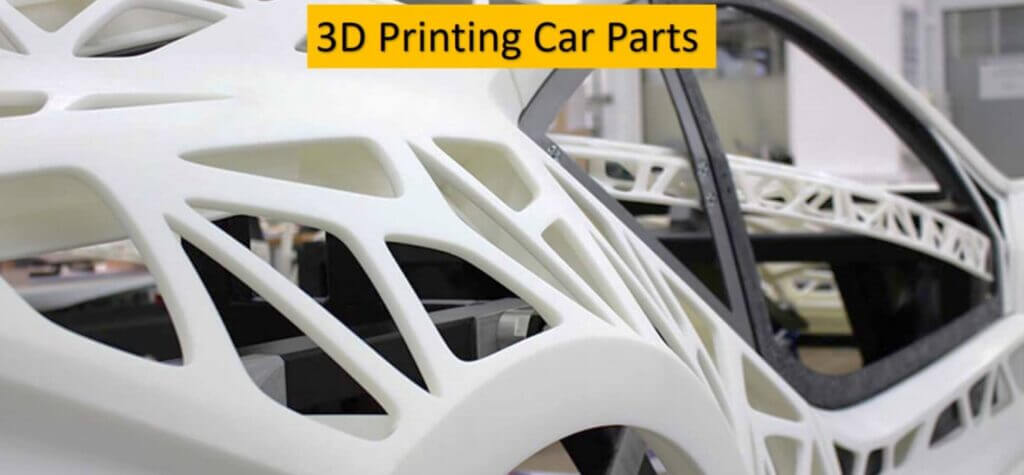Automobile and automotive are two industries that are being transformed by additive manufacturing or 3D printing technologies. Engineers have been creating innovative use cases of 3D printing in the automobile and automotive industries regularly. But one of the common use cases of additive manufacturing in these industries is the 3D printing of car parts.
While planning automotive projects, engineers these days reduce both production time and costs by replacing conventional production methods. Engineers combine the right 3D printing machine and materials to produce both new and customized car parts in a short amount of time. There are a number of reasons why companies prefer 3D printing car parts.
Why do Automotive Companies prefer 3D Printing Car Parts?
While producing car parts, engineers opt for 3D printing to overcome the major shortcomings of traditional or subtractive manufacturing methods. In addition to facilitating low-volume and on-demand production of car parts, 3D printing machines create opportunities for customizations and optimizations. Here are some of the reasons why engineers prefer to 3D print car parts to produce car parts.
Shorten Lead Time
The conventional production methods are vulnerable to manufacturing line downtime. In addition to increasing lead time, the manufacturing line downtime often results in huge financial losses. Automotive companies these days overcome this barrier by 3D printing spare parts. 3D printing technologies enable engineers to produce various car parts individually and regularly.
Curtail Production Costs
While using subtractive manufacturing methods, companies incur additional expenses to transport and store spare parts. But 3D printing technologies enable them to curtail costs by producing spare parts on demand. Also, the automotive companies are not required to invest in infrastructure and human resources as 3D printers support programmed manufacturing.
Maximize Material Usage
The subtractive manufacturing methods produce automotive parts from a block or sheet of metal. Hence, engineers find it challenging to reduce material consumption and wastage. 3D printing technologies produce car parts by sintering powdered raw materials. The engineers can recycle and reuse the unsintered materials in the future to print other automotive parts.
Ensure Dimensional Accuracy
The new-generation automotive projects require engineers to produce cart parts with intricate designs and complex geometries. Also, they have to maintain the dimensional accuracy of the part to boost the car’s performance and driver experience. 3D printing technologies help engineers produce complex car parts with the highest precision without investing extra time and resources.
Options to Reuse and Customize
3D printers produce car parts physically from digital 3D files. The CAD files can be stored seamlessly on a computer or in the cloud. Hence, engineers can access the digital file and print the required car parts whenever the need arises. At the same time, they can customize and refine the car parts by making changes to the CAD design.
How do Engineers 3D Print Different Car Parts Accurately?
Like other models and objects, car parts are produced from digital files using 3D printing technologies. The digital models are created using 3D modeling software. Engineers evaluate and refine the digital file before starting the 3D printing process. Also, they focus on combining the right 3D printing machine and filament before the additive manufacturing process commences.
Digital Model to 3D Print Car Parts
As mentioned earlier, 3D printers produce car parts from digital models. Engineers use 3D modeling software to design new car parts. Likewise, they can use the 3D modeling software to customize and optimize an existing car part.
Before starting the 3D printing process, designers and engineers spend time creating or evaluating the digital model according to precise project needs. The digital files make it easier for engineers to customize and alter car parts before they are produced physically using 3D printers.
Machines for 3D Printing Car Parts
Automotive companies produce car parts using large and industrial 3D printers. Some of these 3D printers support print volumes up to 800 x 600 x 600 mm. Also, these 3D printing machines support multiple materials, including nylon, ABS, PLA, TPE, TPU, and PETG.
Some of these state-of-the-art machines are capable of printing most components of electronic cars. The automotive companies improve print quality and dimensional accuracy by planning and monitoring the 3D printing process by skilled and experienced technicians.
Materials for 3D Printing Car Parts
In addition to supporting multiple materials, industrial-grade 3D printers these days produce multi-material parts. Automotive companies invest in the new-generation 3D printers to print car parts using the best-suited materials or filaments.
The 3D printers facilitate user interaction through touch screens. Engineers can use the touch screen to switch from one filament to another. Once a specific filament is used up by the machine, they can continue 3D printing of car parts using another filament.
Things to Consider
Many car owners and hobbyists these days produce specific car parts using desktop 3D printers. Many automotive companies and online platforms make it easier for them to 3D print car parts by hosting thousands of digital models of various car parts.
But they must remember that automotive companies produce car parts accurately using state-of-the-art 3D printers. Also, these companies set up dedicated 3D printing facilities by investing millions of dollars. Hence, desktop 3D printers can produce only specific car parts accurately.
The hobbyists can use a desktop 3D printer to produce a slew of non-safety-related parts, including clips, knobs, and cupholders. They must not use desktop 3D printers to produce automotive parts that need to resist pressure, tension, and high temperature continuously during real-time use.
Conclusion
An automotive company can save both time and resources by 3D printing cart parts. It can print car parts regularly in a variety of ways – printing in-house and availing of professional 3D printing services. Many car owners avail of professional 3D printing services to 3D print car parts by overcoming constraints related to experience, expertise, and resources.
Leading 3D printing companies like Aurum3D have built a reputation by designing and producing car parts for leading automotive and automobile companies. They make it easier for automotive companies to produce customized car parts by combining the right 3D printing machine, materials, and best practices.

